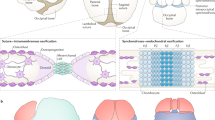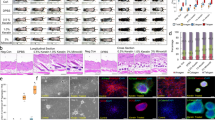Abstract
Both marine and human epidermal growth factors (EGFs) are known to cause precocious opening of the eyelids in newborn mice1–3. Another set of peptides that are structurally and functionally homologous to murine and human EGFs are the murine and human type-α transforming growth factors (TGF-αs)4–7. TGF-αs have been found in many cancer cells and it has been suggested that their autocrine action may play an important part in malignant transformation8–11. In several in vitro systems murine and human TGF-αs are functionally interchangeable with murine and human EGFs6,12–14. However, the in vivo activity of the TGF-αs has not been characterized, as only small amounts of these peptides were available until recently. The cloning of the gene for human TGF-α and its expression in Escherichia coli6 now allow us to demonstrate that human TGF-α is as active as murine EGF in promoting eyelid opening in newborn mice. Furthermore, we show in a dose-dependent eyelid opening assay that human EGF is as potent as its murine homologue with respect to this biological property.
This is a preview of subscription content, access via your institution
Access options
Subscribe to this journal
Receive 51 print issues and online access
$199.00 per year
only $3.90 per issue
Buy this article
- Purchase on Springer Link
- Instant access to full article PDF
Prices may be subject to local taxes which are calculated during checkout
Similar content being viewed by others
References
Cohen, S. J. biol. Chem. 237, 1555–1562 (1962).
Gregory, H. Nature 257, 325–327 (1975).
Cohen, S. & Carpenter, G. Proc. natn. Acad. Sci. U.S.A. 72, 1317–1321 (1975).
Marquardt, H., Hunkapiller, M. W., Hood, L. E. & Todaro, G. J. Science 223, 1079–1082 (1984).
Marquardt, H. & Todaro, G. J. J. biol. Chem. 257, 5220–5225 (1982).
Derynck, R., Roberts, A. B., Winkler, M. E., Chen, E. Y. & Goeddel, D. V. Cell 38, 287–297 (1984).
Roberts, A. B., Frolik, C. A., Anzano, M. A. & Sporn, M. B. Fedn Proc. 42, 2621–2626 (1983).
De Larco, J. E. & Todaro, G. J. Proc. natn. Acad. Sci. U.S.A. 75, 4001–4005 (1978).
Todaro, G. J., Fryling, C. & De Larco, J. E. Proc. natn. Acad. Sci. U.S.A. 77, 5258–5262 (1980).
Sporn, M. B. & Todaro, G. J. New Engl. J. Med. 303, 878–880 (1980).
Sporn, M. B. & Roberts, A. B. Nature 313, 745–747 (1985).
Anzano, M. A. et al. Cancer Res. 42, 4776–4778 (1982).
Massagué, J. J. biol. Chem. 258, 13606–13613, 13614–13620 (1983).
Twardzik, D. R., Todaro, G. J. & Marquardt, H. Science 216, 894–897 (1982).
Cohen, S. & Carpenter, G. A. Rev. Biochem. 48, 193–216 (1979).
Hollenberg, M. D. Vitam. Horm. 37, 69–110 (1979).
Smith, J. et al. Nucleic Acids Res. 10, 4467–4482 (1982).
Roberts, A. B., Anzano, M. A., Lamb, L. C., Smith, J. M. & Sporn, M. B. Proc. natn. Acad. Sci. U.S.A. 78, 5339–5343 (1981).
Savage, C. R. & Cohen, S. J. biol. Chem. 247, 7609–7611 (1972).
Assoian, R. K., Komoriya, A., Meyers, C. A., Miller, D. M. & Sporn, M. B. J. biol. Chem. 258, 7155–7160 (1983).
Author information
Authors and Affiliations
Rights and permissions
About this article
Cite this article
Smith, J., Sporn, M., Roberts, A. et al. Human transforming growth factor-α causes precocious eyelid opening in newborn mice. Nature 315, 515–516 (1985). https://doi.org/10.1038/315515a0
Received:
Accepted:
Issue Date:
DOI: https://doi.org/10.1038/315515a0
This article is cited by
-
Signaling cross-talk between TGF-β/BMP and other pathways
Cell Research (2009)
-
SPECT Imaging with 99mTc-Labeled EGFR-Specific Nanobody for In Vivo Monitoring of EGFR Expression
Molecular Imaging and Biology (2008)
-
EGF and TGF-α in the human kidney: Identification of octopal cells in the collecting duct
Kidney International (1994)
-
Transforming growth factor-alpha is a constant component of human tear fluid
Graefe's Archive for Clinical and Experimental Ophthalmology (1994)
-
Potential role of the epidermal growth factor receptor in human pancreatic cancer
International journal of pancreatology (1990)
Comments
By submitting a comment you agree to abide by our Terms and Community Guidelines. If you find something abusive or that does not comply with our terms or guidelines please flag it as inappropriate.



